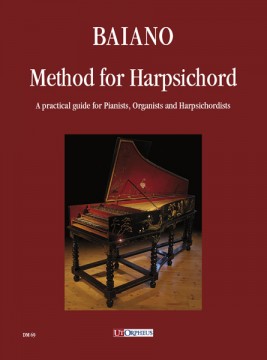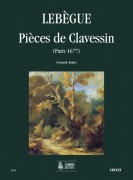Enrico Baiano
Method for Harpsichord. A practical guide for Pianists, Organists and Harpsichordists
- Editore: Ut Orpheus
- Codice: DM 69
- Disponibile
-
€ 47,95
This manual sets out to analyse and tackle the key problems posed by harpsichord technique. Since people often begin to study the harpsichord after spending years learning the piano or the organ and playing music of the 19th and 20th centuries, they invariably come up against all sorts of technical problems. The technique used on the piano and organ is simply not suitable for an instrument in which the strings are plucked. The harpsichord is in fact a totally different instrument, with its own characteristics and requiring a specific technique. A misguided technical approach can have fatal consequences for the quality of the sound produced by the aspiring harpsichordist. The sound cannot be properly calibrated in the service of interpretation, and may well be marred by extraneous mechanical noises. In extreme cases, even when the performer is aiming to be stylistically correct, the technical problems can make for a performance which is at best laboured and may simply prove unattainable; it may also result in damage to the instrument. Thus it is vitally important for teacher and student to dedicate time to rethinking and rebuilding the student’s technique.
The principles outlined here can be applied with just a few modifications to the clavichord and the fortepiano. The student will find three types of musical excerpts: purely technical exercises, which isolate the specific movement to be mastered; short fragments – what François Couperin styled évolutions – in which the movement is practised in a more authentic context; and studies which are more complex in scope. The author has chosen not to start from the elementary stage, since this is dealt with in other methods, but rather to go in some detail into the intermediate and advanced levels. The material has been largely transcribed or adapted from the harpsichord repertoire; in some cases Baiano has composed it himself. Except when it comes to scales, the author has deliberately avoided quoting from the recognised manuals. In the historical literature technical instructions tend to be of a general nature, while Baiano's aim here is to ‘take students by the hand’ and help them gradually to acquire (or perfect) the fundamental mechanisms which are indispensable for successful harpsichord playing.
The author has also deliberately kept the section devoted to interpretation quite short: if one were to go in depth into all the problems concerned with style and expression (and could one ever cover them all?), this would require a massive volume all to itself. Besides, the danger is always for a written text to turn into dogma, laying down sterile rules which cannot possibly encompass all the infinite variables that crop up in musical discourse. Music has to be made; it can only be explained up to a point. Thus Baiano has chosen to restrict himself to a few words of advice, just to start the performer off, aware that whatever he says will have its limits in practice. He remains convinced that personal experience and work alongside a teacher are immeasurably more fruitful.
The principles outlined here can be applied with just a few modifications to the clavichord and the fortepiano. The student will find three types of musical excerpts: purely technical exercises, which isolate the specific movement to be mastered; short fragments – what François Couperin styled évolutions – in which the movement is practised in a more authentic context; and studies which are more complex in scope. The author has chosen not to start from the elementary stage, since this is dealt with in other methods, but rather to go in some detail into the intermediate and advanced levels. The material has been largely transcribed or adapted from the harpsichord repertoire; in some cases Baiano has composed it himself. Except when it comes to scales, the author has deliberately avoided quoting from the recognised manuals. In the historical literature technical instructions tend to be of a general nature, while Baiano's aim here is to ‘take students by the hand’ and help them gradually to acquire (or perfect) the fundamental mechanisms which are indispensable for successful harpsichord playing.
The author has also deliberately kept the section devoted to interpretation quite short: if one were to go in depth into all the problems concerned with style and expression (and could one ever cover them all?), this would require a massive volume all to itself. Besides, the danger is always for a written text to turn into dogma, laying down sterile rules which cannot possibly encompass all the infinite variables that crop up in musical discourse. Music has to be made; it can only be explained up to a point. Thus Baiano has chosen to restrict himself to a few words of advice, just to start the performer off, aware that whatever he says will have its limits in practice. He remains convinced that personal experience and work alongside a teacher are immeasurably more fruitful.
Autore: Enrico Baiano
Data pubblicazione: Seconda edizione 30/3/2010
Pagine: pp. 228
Formato: 230x310 mm
Rilegatura: Brossura (copertina morbida)
ISMN: 979-0-2153-1882-3
Codice: DM 69

 Enrico Baiano è oggi considerato uno dei più completi e interessanti interpreti sulla scena della musica antica.
Enrico Baiano è oggi considerato uno dei più completi e interessanti interpreti sulla scena della musica antica. Nato a Napoli nel 1960, si è brillantemente diplomato in pianoforte e composizione presso il Conservatorio «San Pietro a Majella» di Napoli, specializzandosi poi in clavicembalo, clavicordo e fortepiano con Emilia Fadini presso il Conservatorio «Giuseppe Verdi» di Milano.
Ha suonato per i più importanti festival di musica antica. Ha registrato otto CD per l’etichetta Symphonia, tutti accolti entusiasticamente dalla critica e più volte premiati (Deutsche Schallplattenpreis, Diapason d’Or, Choc de la Musique, Platte des Monats). Ha registrato per varie radio e televisioni europee. Collabora con l’ensemble di musica contemporanea Dissonanzen e con Piccolo Concerto Wien. Ha preso parte al film-documentario su Domenico Scarlatti Un gioco ardito, del regista Francesco Leprino. Dal 1986 al 2000 ha suonato con il gruppo vocale-strumentale Cappella della Pietà dei Turchini, con il quale ha registrato dieci CD per le etichette Symphonia e Opus 111.
È docente di clavicembalo e tastiere storiche presso il Conservatorio «Domenico Cimarosa» di Avellino.
Harpsichord & Fortepiano (Autumn 2012)
... the Method is a useful contribution to early keyboard study for teachers and students alike. One may not agree with all of Mr. Baiano’s ideas, but the general scope of information is well thought out, and the plethora of examples is most welcome.
... the Method is a useful contribution to early keyboard study for teachers and students alike. One may not agree with all of Mr. Baiano’s ideas, but the general scope of information is well thought out, and the plethora of examples is most welcome.
Deutsche Clavichord Societät Rundbrief n. 60 (2010)
... Falls jemand sein historisches Tasteninstrument gern in der Methodik der Schulen des 19. und 20. Jahrhunderts erlernen möchte, wird er in diesem Werk einen hilfreichen und gut strukturierten Begleiter finden ... (Diez Eichler)
... Falls jemand sein historisches Tasteninstrument gern in der Methodik der Schulen des 19. und 20. Jahrhunderts erlernen möchte, wird er in diesem Werk einen hilfreichen und gut strukturierten Begleiter finden ... (Diez Eichler)
Luzzaschi, Luzzasco Opera Strumentale. Toccata, Canzone, Ricercare e Fantasie intavolati per Organo o Clavicembalo
ES 13 - € 24,95
Lebègue, Nicolas Antoine Pièces de Clavessin (Paris 1677) per Clavicembalo
ES 17 - € 23,95
Battiferri, Luigi Ricercare a quattro, cinque e sei voci (Bologna 1669) per Organo o Clavicembalo
ES 22 - € 20,95







